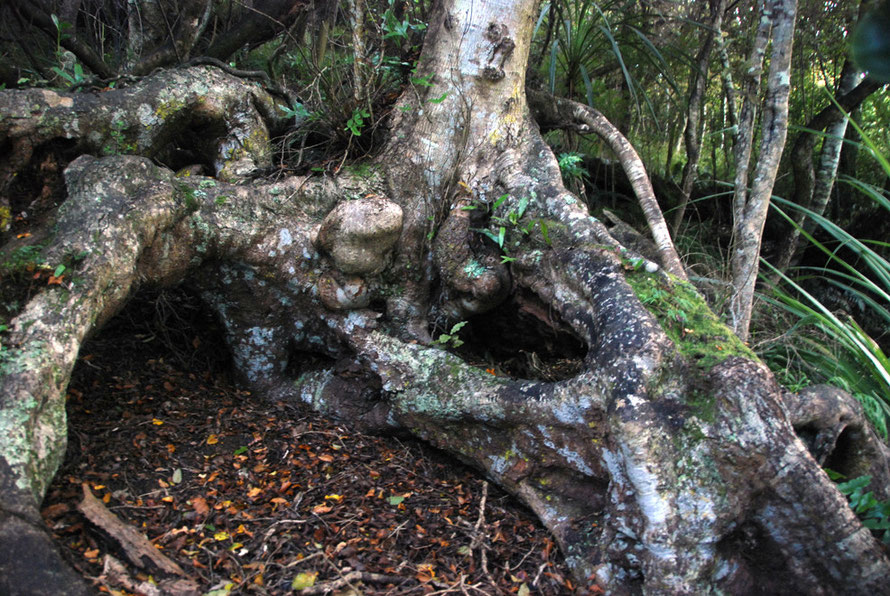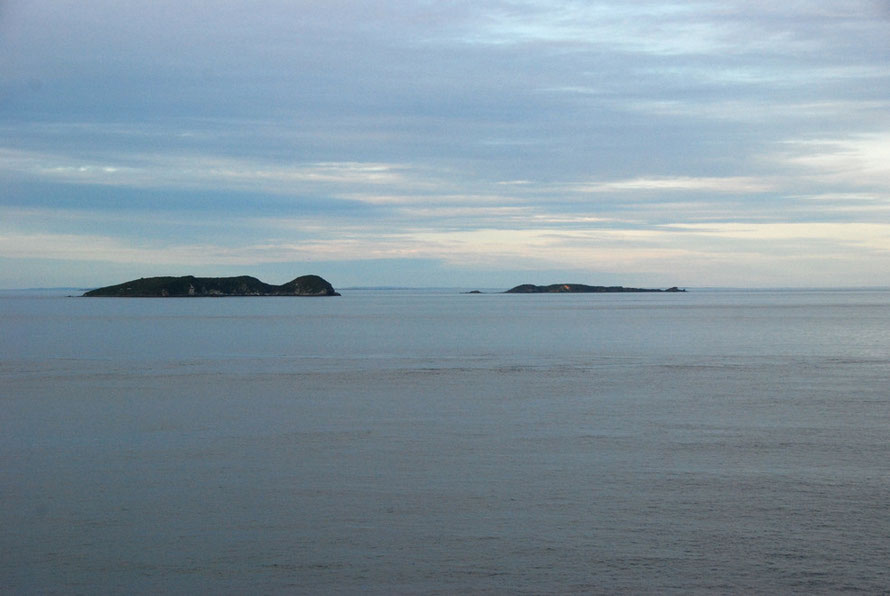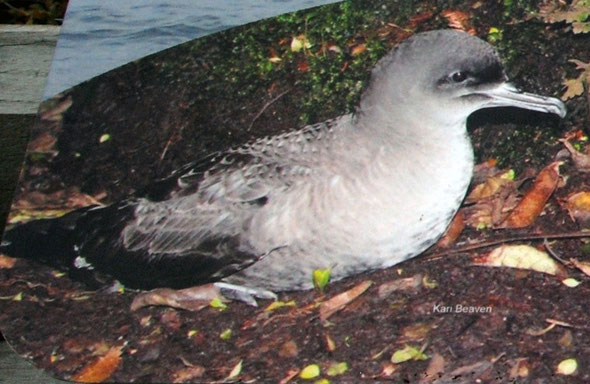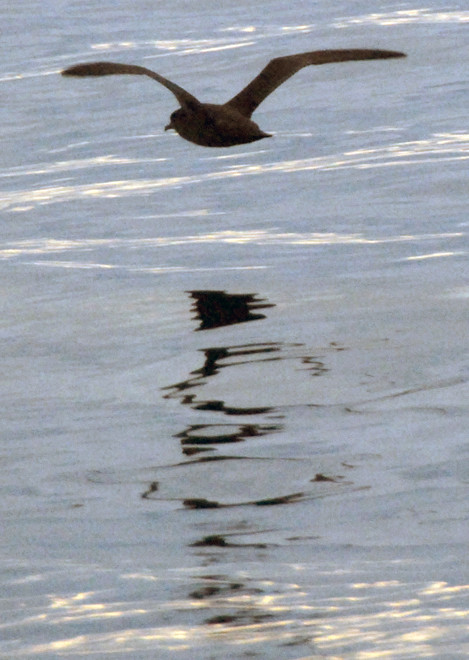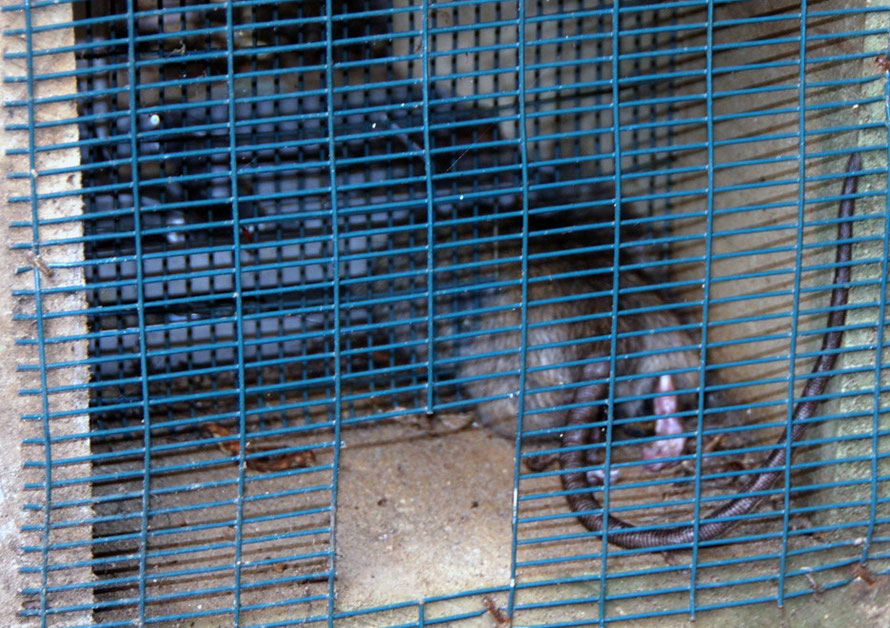VII. Sooty Shearwaters and Blue Penguins
Of the seventeen species of penguin, six live and breed in New Zealand. The full list is the Blue, the Erect-Crested, the Fjordland, The Rockhopper, the Snares and the Yellow-Eyed.
In passing it is a noteworthy fact that penguins only occur in sub-Antarctic waters while Polar Bears only occur in sub-Acrtic waters.
We saw and heard from a distance one of New Zealand's penguins, the Blue.
All close-up photos on this page are borrowed, acknowledged and linked to their home site.
The Blue Penguin
The Blue or Little penguin/korora (Eudyptula minor), is found in many places in New Zealand and is the world's smallest penguin.
The Blue is 25 cm tall and weighs about 1kg.
The birds are hard to see as they only return to their burrows ashore under the cover of darkness. However, Blues will nest close to humans under buildings, stacks of timber or even railway tracks. On Stewart Island they breed near the big oil tanks by the main landing.
Usually two eggs are laid between September to November. The chicks grow rapidly, with adult weight being achieved in 4-5 weeks. At 8 weeks the chicks fledge and from then are independent. There is a high rate of juvenile mortality and Blues can live for 25 years.
Blues are very vulnerable to predation from introduced ferrets, stoats, and weasels and have been decimated in mainland colonies. Dogs are also major predators - particularly of penguins returning from the sea. And from the air the southern brown skua is a vicious predator.
The NZ Department of Conservation ranks the blue penguin as "Lower risk - near threatened".
On the second evening of our stay on Stewart Island we walked out to the end of Ackers Point in search of Blue Penguins/korora and Sooty Shearwaters/titi. The idea was to wait until darkness fell. This was supposed to bring on two natural-world phenomena.
In the first place Blue Pengiuns would return to their burrows from a day out foraging at sea (they can make daily round trips of up to 75km).
In the second place hundreds of Sooty Shearwaters - also known as 'mutton birds' - would plump 'like falling ripe fruit in an orchard' into the thickets of vegetation surrounding the lookout to take to their burrows for the night.
We took industrial-strength sandfly repellent, a rather feeble torch, binoculars, my camera, a telescope and warm clothes.
We had walked out to Ackers Point first thing in the morning. The path was well-marked and made up. However, it went through thick bush in places and there were precipitous falls from the serpentine curves described by the path's route to the rocky headland.
Low branches of giant fuscia trees lay in wait for the unwary walker.
We had been incredibly lucky with the weather. Despite being down amongst the supposedly 'Roaring Forties' we barely felt a breeze the two and half day we were on Stewart Island.
Earlier in the day we had walked the beginning of the seven-day tramp around the island in bright sunshine. We had become separated and somehow had gotten on different forks of a blindingly-obvious trail.
As a consequence considerable amounts of panicky energy had been expended as I searched for my partner-in-crime in pretty remote back-country. In two hours of hard walking I passed two young, lank-haired German women making their way to the trailhead after days without hairdryers. They looked relatively happy and not unduly perturbed.
So by the evening-fall we were both pretty knackered but we urged ourselves out to the Point with the familiar 'But we may never come back here again' refrain.
The evening was calm and warm with high cloud filling the sky. We clomped our way out to the headland in great expectation.
The wait was enjoyable as the light fell. We thought we might be fighting of other birders but we were blissfully alone in the growing dark until we were joined briefly by a woman who alerted us to the cough-like barks of the returning Blues. For some reason she had 'forgotten' her binoculars and declined to have a borrow of ours.
By diligent scanning of the glassy waters I eventually managed to see three black and white shapes that looked, with their charateristic low-lying pose, to be penguins.
We hung around hoping the Blues might come closer and hop up on the spur of rock to our left but it was not to be. Apart from this area everything else below us was obscured by bush that grew right to the sea's edge.
The evening drew on - it was getting dark by eight o'clock. We could see a group of shearwaters way out in water but they declined to move in our direction.
(There is a nice audio clip of Blue Penguins in their burrows on this Stewart Island website www.sailsashore.co.nz).
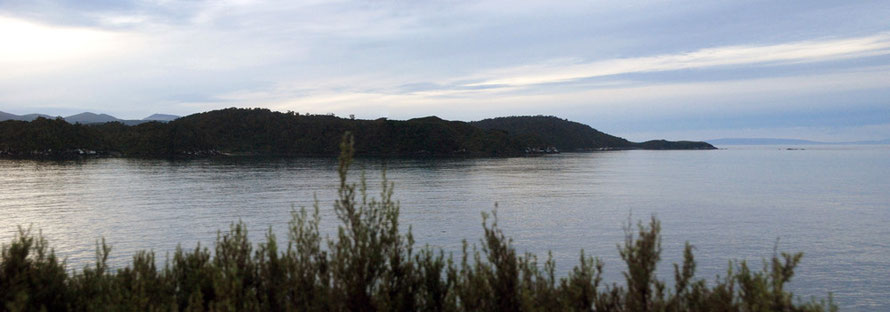
An informative sign told us that the Sooty Shearwater is New Zealand's most populous sea bird with an estimated population of 20 million. Nearly half of these breed around Stewart Island. Arriving in late September to early November the adult birds - Kaiaka - return year after year to the same nesting burrow.
The attraction for the Sooty Sheerwater is not only the uninhabited islands for nesting but also the richness of the marine life in Foveaux Strait.
This is fed by the Southland Current which is an off-shoot of the Tasman current. The latter is 'made up largely of subtropical waters mixed with some Australasian sub-antarctic waters'. It is these colder waters that are abundant in marine life.
(See Jacomb, C., Walter, R., Amd Jennings C. (2010)Review of the Archeology of the Foveaux Strait, New Zealand, The Journal of the Polynesian Society Vol. 119, No. 1 p. 26.)
The birds have a single chick which is left for three-five day periods as both adults fly prodigious distances to secure food - regurgitated fish oil- for baby. As night falls hundreds if not thousands of birds are supposed to perform soft landings into the bush near their burrow entrances.
If we had asked the informed owners of the upscale bach in which we were staying for advice on the Sooty issue I dare say they would have quickly told us that the breeding season was over and that we'd be wasting our time stuck out on the Point in the dark.
Indeed, the Sooties undertake a most heroic journey once fledged. From late March to early May most birds leave New Zealand and embark on a 64,000km round trip to the northern Pacific spending up to 168 days at sea feeding on pilchards, sprats, shrimps and small squid. Remarkably these little birds can also dive to a depth of some 68m.
But it was good to be there, Sooties or no.
We had seen plenty of birds on the water earlier that day and had watched aghast (well - aghast-ishly) as the Stewart Island supply boat, imaginatively named the Foveaux Freighter, headed through a great shoal/flock of the birds as they fed on surface fish.
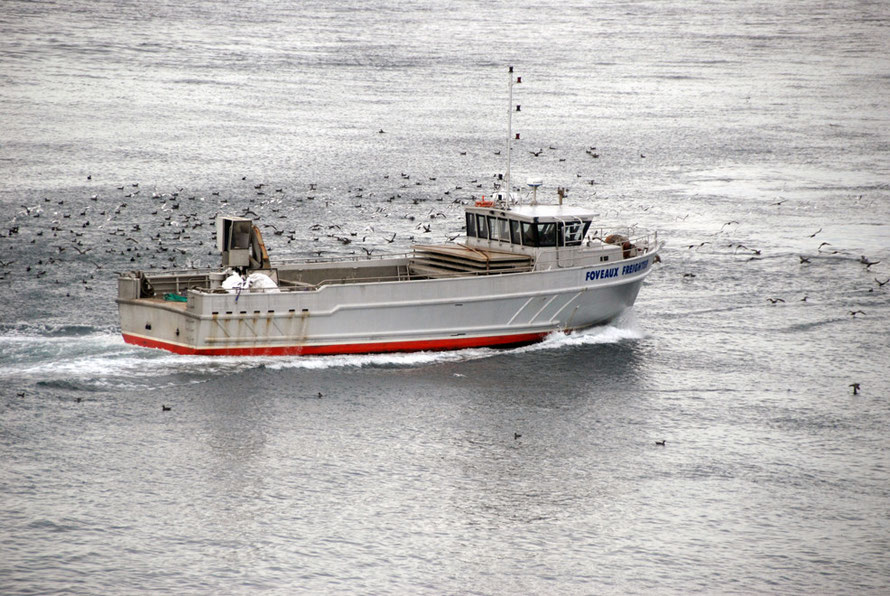
As mentioned the Sooty Shearwater is also ominously known as the 'Muttonbird.' Keri Hulme describes her characters in The Bone People eating the fatty birds.
There is a display in the Dunedin Museum regarding the harvest of Muttonbirds.
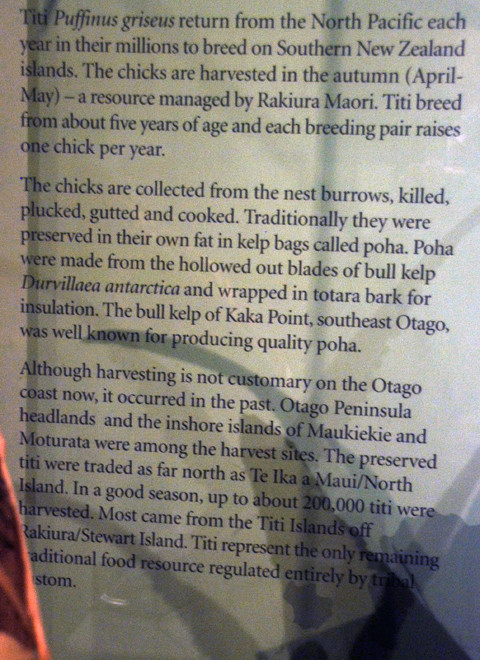
Hot fat was poured over the muttonbirds in a poha - the bag made from split Bull Kelp (see above) and could last like this for six years.
The harvest of Muttonbird's reminded me vividly of the harvest of 'gugas' (fledgling gannets) from the uninhabited island of Sula Sgeir 18 miles off Lewis in the Outer Hebrides. The birds are still harvested and the taste of the pickled gannets is something of an acquired one. Apparently,
In the sixteenth century it was served at the tables of Scots kings and was a favourite with the wealthy as a ’whet’ or appetizer before main meals.
The guga harvest features in the Peter May's excellent Hebridean policier "The Blackhouse" (2011).
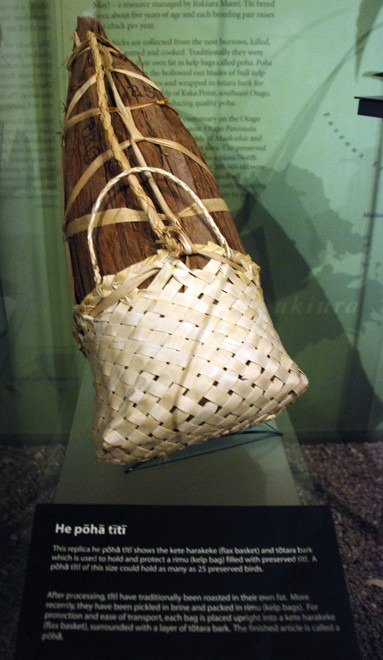
Nzbirdsonline gives the follwing descriptrion of the muttonbird harvest.
The young are harvested at traditional sites around Stewart Island by descendants of Rakiura Maori. 'Muttonbirders' can access the islands from 15 March to prepare for the harvest, which starts on 1 April and can continue until 31 May. During the first half of the season, chicks are extracted from their burrows during the daytime. Once the chicks start emerging at night in preparation for their departure (mainly in May), they are captured in large numbers on the surface, with the daily take limited by the time it takes to pluck and process the birds the following day. The total harvest from the Stewart Island region is estimated to be around 400,000 chicks per annum.

I had read about a terrible boating accident in the papers in Foveaux Strait on a Muttonbird expedition.
Eight people drowned when the Easy Rider was hit by a rogue wave in March 2012 during a muttonbirding trip to the Titi Islands. The only survivor was rescued after 18 hours in the water clinging to a plastic container.
For the trial of the widow of the skipper of the Easy Rider see here. Tragically the widow
and her deceased husband had been involved in the rescue of another fishing party two
months earlier where two men drowned. For personal recollections of muttonbirding see Te Ara
here.
On hearing that the widow, Gloria Davis, had been found guilty Mrs Rena Fowler who had lost two sons, a grandson and a nephew in the Easy Rider disaster told the Otago Daily Times when it contacted her about the verdict,
''Oh no, that's not fair...That sinking had a natural cause. It was one of those things that happen ... Foveaux Strait is an iffy strait.''

All is not well for the Blueys and Sooties. The depredations of mammals introduced into New Zealand, such as rats and stoats, weasels and ferrets threaten these gentle ground-nesting birds. Intensive trapping efforts are ongoing on Ackers Point and in other locations on Stewart Island.
But even when headlands and islands are rid of predators there is the ever-present danger that they will find a way back (rats can swim prodigious distances) and wreak havoc.
The first weekend we were in New Zealand (March 8/9th 2014) the New Zealand Herald ran a poster about the return of breeding seabirds to Little Barrier Island in the Hauraki Gulf (east of Auckland). The endangered Black Petrel/taiko and Grey-faced petrels/oi now breed on the island along with Fluttering Shearwaters/pakaha and Common Diving Petrels/kuaka. Also breeding are the tiny New Zealand storm petrel and Cook's Petrel.
Entrance to Little Barrier Island is by permit only.




